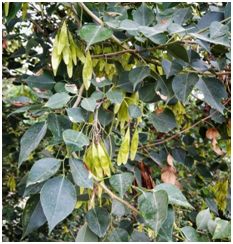
Botanical Name – Dalbergia sissoo DC.
Common Name – Sheesham
Classification –
Kingdom – Plantae
Division – Magnoliophyta
Class – Magnoliopsida
Order – Fabales
Family – Fabaceae
Genus – Dalbergia
Species – sissoo
Characteristics Of Family Fabaceae
This family also called bean and legume .our species in the fabaceae include trees, herbs, shrubs and lianas. The leaves are alternate and in most species are divided into leaflets. Flower may be borne singly or may be grouped into various arrays. Flower are actinomorphic and zygomorphic . the sepal form a tube with lobes that are often of different lengths. The petals are often arranged such that a larger . There are usually 10 stamens and 1 ovary which has a single style and stigma . the fruit ususlly a legume , rarely the fruit is a schizocarp .
Habitat – Dalbergia sissoo is found in tropical to sub tropical climates in natural and planted forest.
Distribution – Jammu & Kashmir , Himachal Pradesh , Sikkim, Arunachal Pradesh , Bihar, Madhya Pradesh.
World distribution – Afghanistan , Iran , India , Pakistan
Status – Least concern
Plant discription –
Tropical trees providing a valuable dark timber, hydrophytes and xerophytes. Tap root system, branched.
Stem attains height of about 100 ft. a girth up to 8 ft. and clear bole up to 35 ft. cylindrical woody.
Leaves: Pinnate leaves with uneven number of leaflets. The leaves are composed of 3-5 broadly elliptic or ovate, acuminate leaflets arranged alternately on somewhat zigzag axis. Inflorescence: Racemose, panicle.
Flowers: Panicle of small, yellow or white papilionaceous and perigynous flowers, hermaphrodite. Fruit is thin, strap-shaped pod, 1-1/2- 4 inches long. .Seed: 1-4 flattened seeds, many, exalbuminous.
Uses
It is highly valued as constructional and general utility timber on the account of its great strength, elasticity and durability and is used for all the purposes for which Indian rosewood is employed in South.
It is esteemed for railway sleepers, musical instruments, Charpai legs, hammer handles, shoe heels, hookah tubes and tobacco pipes.
Carefully selected and manufactured plywood logs satisfy the specifications prescribed for aircraft, and for this purpose, the wood from trees, growing on canal banks and in plantations is considered to be the best.
It is used for making laminated skiis.
It can be worked into decorative ornamental carvings.
The pulp is used for making writing and printing papers.